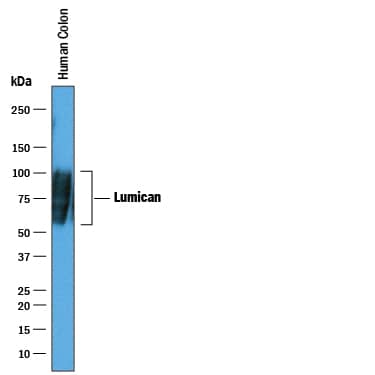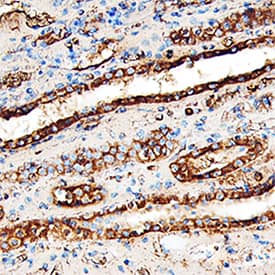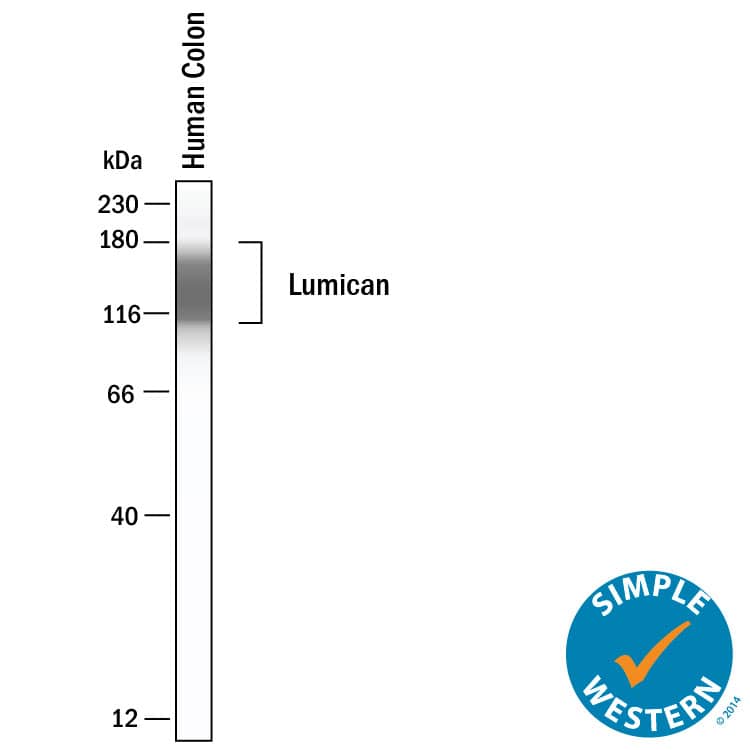Human Lumican Antibody
R&D Systems, part of Bio-Techne | Catalog # AF2846


Key Product Details
Species Reactivity
Validated:
Human
Cited:
Human, Mouse, Bovine
Applications
Validated:
Immunohistochemistry, Simple Western, Western Blot
Cited:
Immunohistochemistry, Immunohistochemistry-Paraffin, Western Blot
Label
Unconjugated
Antibody Source
Polyclonal Goat IgG
Product Specifications
Immunogen
Mouse myeloma cell line NS0-derived recombinant human Lumican
Gln19-Asn338
Accession # P51884
Gln19-Asn338
Accession # P51884
Specificity
Detects human Lumican in direct ELISAs and Western blots. In direct ELISAs, approximately 10% cross‑reactivity with recombinant mouse Lumican is observed.
Clonality
Polyclonal
Host
Goat
Isotype
IgG
Scientific Data Images for Human Lumican Antibody
Detection of Human Lumican by Western Blot.
Western blot shows lysates of human colon tissue. PVDF membrane was probed with 1 µg/mL of Goat Anti-Human Lumican Antigen Affinity-purified Polyclonal Antibody (Catalog # AF2846) followed by HRP-conjugated Anti-Goat IgG Secondary Antibody (Catalog # HAF019). A specific band was detected for Lumican at approximately 60-85 kDa (as indicated). This experiment was conducted under reducing conditions and using Immunoblot Buffer Group 1.Lumican in Human Kidney.
Lumican was detected in immersion fixed paraffin-embedded sections of human kidney using Goat Anti-Human Lumican Antigen Affinity-purified Polyclonal Antibody (Catalog # AF2846) at 15 µg/mL overnight at 4 °C. Tissue was stained using the Anti-Goat HRP-DAB Cell & Tissue Staining Kit (brown; Catalog # CTS008) and counterstained with hematoxylin (blue). Specific staining was localized to convoluted tubules. View our protocol for Chromogenic IHC Staining of Paraffin-embedded Tissue Sections.Detection of Human Lumican by Simple WesternTM.
Simple Western shows lysates of human colon tissue, loaded at 0.5 mg/ml. A specific band was detected for Lumican at approximately 100-180 kDa (as indicated) using 10 µg/mL of Goat Anti-Human Lumican Antigen Affinity-purified Polyclonal Antibody (Catalog # AF2846). This experiment was conducted under reducing conditions and using the 12-230kDa separation system.Applications for Human Lumican Antibody
Application
Recommended Usage
Immunohistochemistry
5-15 µg/mL
Sample: Immersion fixed paraffin-embedded sections of human kidney
Sample: Immersion fixed paraffin-embedded sections of human kidney
Simple Western
10 µg/mL
Sample: Human colon tissue
Sample: Human colon tissue
Western Blot
1 µg/mL
Sample: Human colon tissue
Sample: Human colon tissue
Formulation, Preparation, and Storage
Purification
Antigen Affinity-purified
Reconstitution
Reconstitute at 0.2 mg/mL in sterile PBS. For liquid material, refer to CoA for concentration.
Formulation
Lyophilized from a 0.2 μm filtered solution in PBS with Trehalose. See Certificate of Analysis for details.
*Small pack size (-SP) is supplied either lyophilized or as a 0.2 µm filtered solution in PBS.
*Small pack size (-SP) is supplied either lyophilized or as a 0.2 µm filtered solution in PBS.
Shipping
Lyophilized product is shipped at ambient temperature. Liquid small pack size (-SP) is shipped with polar packs. Upon receipt, store immediately at the temperature recommended below.
Stability & Storage
Use a manual defrost freezer and avoid repeated freeze-thaw cycles.
- 12 months from date of receipt, -20 to -70 °C as supplied.
- 1 month, 2 to 8 °C under sterile conditions after reconstitution.
- 6 months, -20 to -70 °C under sterile conditions after reconstitution.
Background: Lumican
References
- Nikitovic, D. et al. (2008) IUBMB Life 60:818.
- Blochberger, T.C. et al. (1992) J. Biol. Chem. 267:347.
- Chakravarti, S. et al. (1998) J. Cell Biol. 141:1277.
- Chakravarti, S. et al. (2000) Invest. Ophthalmol. Vis. Sci. 41:3365.
- Jepsen, K.J. et al. (2002) J. Biol. Chem. 277:35532.
- Chakravarti, S. et al. (2003) Invest. Ophthalmol. Vis. Sci. 44:2422.
- Vuillermoz, B. et al. (2004) Exp. Cell Res. 296:294.
- Nikitovic, D. et al. (2008) FEBS J. 275:350.
- D’Onofrio, M.F. et al. (2008) Biochem. Biophys. Res. Commun. 365:266.
- Ishiwata, T. et al. (2007) Oncol. Rep. 18:537.
Alternate Names
LDC, LUM, SLRR2D
Gene Symbol
LUM
UniProt
Additional Lumican Products
Product Documents for Human Lumican Antibody
Product Specific Notices for Human Lumican Antibody
For research use only
